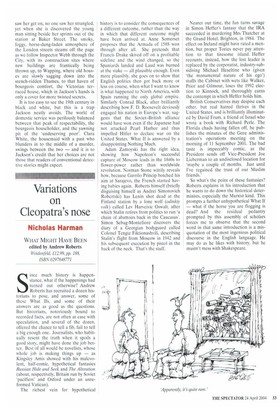Dark deeds
on the District Line
Judith Flanders
A METROPOLITAN MURDER by Lee Jackson Heinemann, f12.99, pp. 320, ISBN 0434012297 1 n 1863, the London underworld was revolutionised — not the crime statistics, but the literal underworld, when the first underground railway opened, with trains running, unimaginably, beneath the surface of the earth. This was, as the Times had pointed out when plans were first mooted, as silly as thinking of machines that could fly through the air, or of battles that could be fought in the sky, or trains running in tunnels under the Channel.
By 1865, it was possible to travel between Farringdon Street and Paddington without seeing daylight; within a decade areas as far north as Swiss Cottage, as far west as Kensington and Hammersmith, as far east as Liverpool Street, all had the new 'Underground Railway', and, from being unimaginable, underground travel was a daily method of transport for thousands of commuters and housewives, who made their decisions to travel based solely on the congestion of the London streets, and their ability to tolerate tunnels filled with coal-smoke and gas-fumes from the engines and carriage-lights.
With mass transit underground, though, came the sort of dangers that lurked above ground too: fire, theft, even murder. (The Fenians were quick to understand the possibilities for spreading terror in enclosed spaces: they exploded nitroglycerine in the tunnel of the District Railway soon after it opened, with three further explosions in the two decades that followed. We must hope that al-Qa'eda are not students of Victoriana.)
The same cannot be said of Lee Jackson, who in his second foray into Victorian death brings Inspector Decimus Webb, the velocipede-riding detective, to solve a brutal 'Railway Murder'. Jackson runs the wonderful www.victorianlondon.org website, which is a cornucopia of little-known Victorian texts highlighting aspects of daily life in the 19th century, and it is clear from A Metropolitan Murder that he has studied them to good effect. A young girl is found dead in a railway carriage: no one
saw her get on, no one saw her strangled, yet when she is discovered the young man sitting beside her sprints out of the station at Baker Street. The smoky, foggy, horse-dung-laden atmosphere of the London streets steams off the page as we follow Inspector Webb through the City, with its construction sites where new buildings are frantically being thrown up, to Wapping, where old houses are slowly sagging down into the stench-ridden Thames, to that haven of bourgeois comfort, the Victorian terraced house, which in Jackson's hands is only a cover for more twisted secrets.
It is too easy to see the 19th century in black and white, but this is a trap Jackson neatly avoids. The world of domestic service was perilously balanced between that peak of respectability, the bourgeois householder, and the yawning pit of the 'undeserving poor'. Clara White, the housemaid with a past who blunders in to the middle of a murder, swings between the two — and it is to Jackson's credit that her choices are not those that readers of conventional detective stories might expect.



















































































 Previous page
Previous page